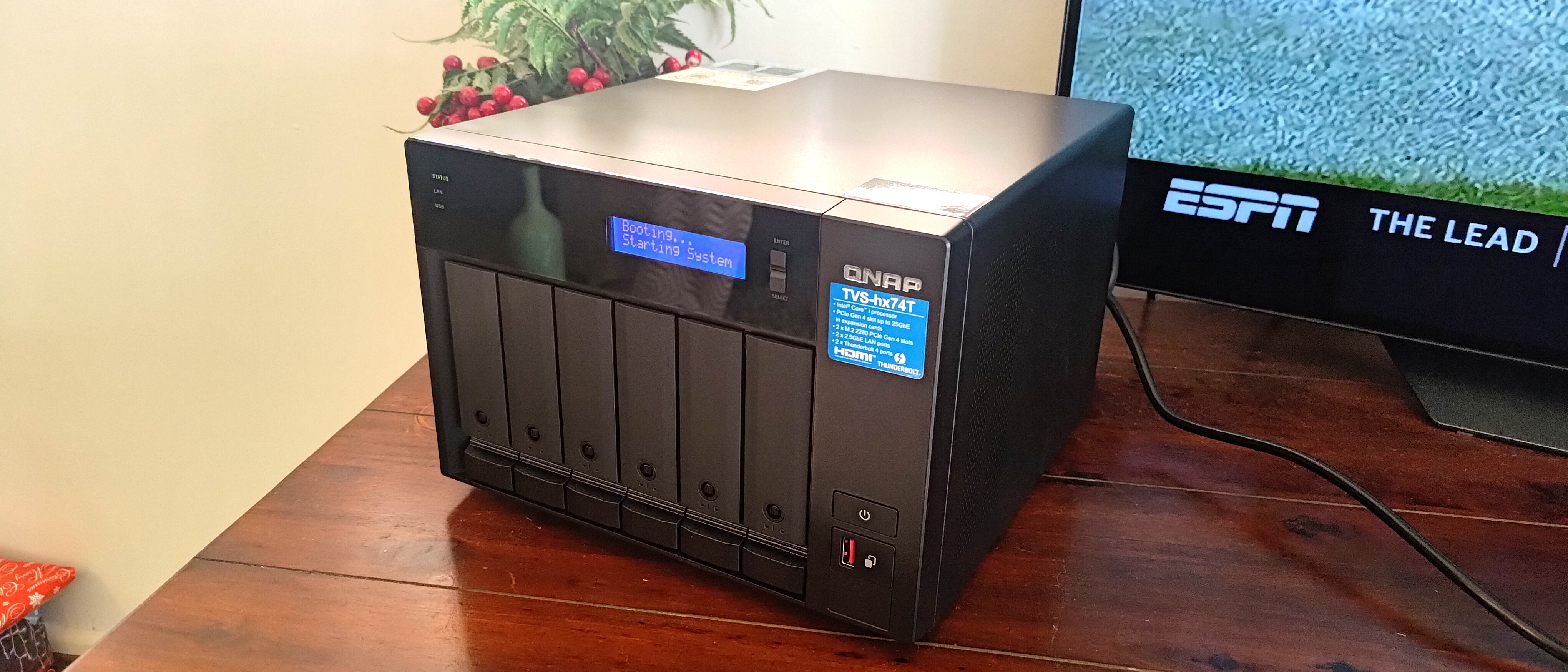TechRadar Verdict
It’s expensive, but for demanding users the improved Thunderbolt 4 performance could help the QNAP TVS-h674T pay for itself.
Pros
- +
Speedy Thunderbolt 4 connectivity
- +
Multiple drive configurations
- +
Significant upgrade potential
Cons
- -
Very expensive
- -
Difficult to realise full-speed potential
Why you can trust TechRadar
The QNAP TVS-h674T looks and feels like a high-quality device. It’s got quick release drive bays where it needs them but adding additional hardware simply involves unscrewing the case. It’s simple to set-up thanks to an intuitive app and a well-honed installation process and it’s simple to access locally and across the internet. The killer feature is the Thunderbolt 4 connectivity, which facilitates fast data transfer onto the NAS’s own drives or through the NAS on its way to one, or multiple, devices on a network at once. This potentially removes the necessity of buying multiple, expensive hard drives for work with massive video files, but you’ll need a bleeding edge network to realise this potential.
Unboxing and first impressions
As seems to be the law in NAS land, the QNAP TVS-h674T arrives boxed within a box for maximum protection. However, once extricated, you’re simply left with a NAS box, power cable and a box of screws for potential upgrades. A status display on the front looks smart but isn’t overly useful. Included literature tells you to download the QNAP app, follow the prompts and within 10 minutes you reach a point where drives are ready to be inserted and formatted.
Design and build quality
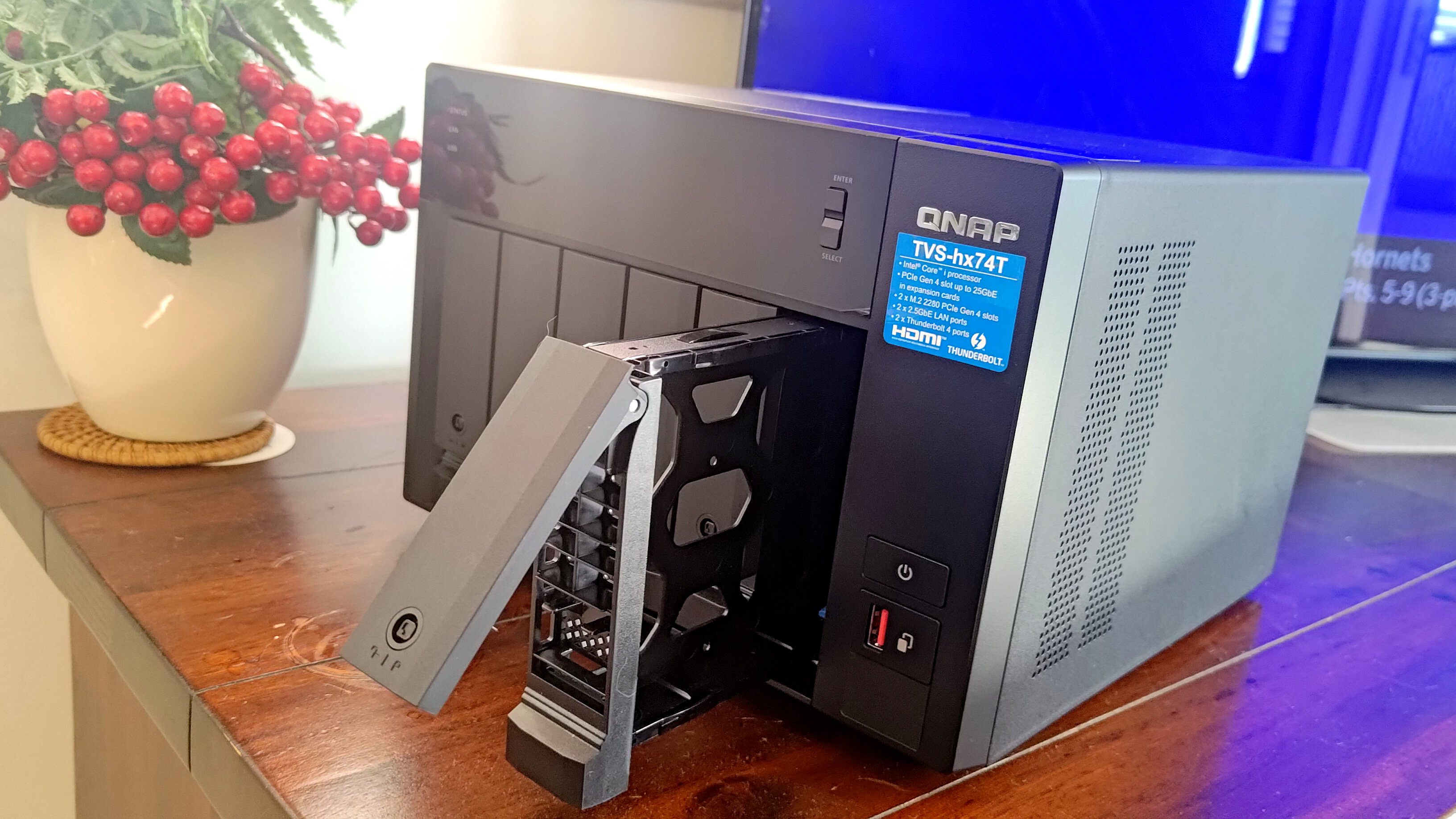
CPU: 2.5-4Ghz hexa-core Intel Core i5-12400 (12-thread)
Memory: 32GB DDR4 RAM (expandable to 64GB)
Compatible Drive Types: 6 x 3.5 or 2.5-inch SATA HDD/SSD and 2 x m.2 2280 slots
Ports: 2 x Thunderbolt 4, 1 x USB-C 3.2, 2 x USB-A 3.2, 2 x 2.5 Gigabit Ethernet, 1 x HDMI 1.4b
Dimensions: 180 x 264 x 280mm
Weight: 6.4kg
Low-to-mid-range NAS boxes have a tendency to feel like expensive, cheap metal hollow boxes, but there’s more of a feeling of robust quality with an unladen QNAP TVS-h674T. The LCD panel adds to this, although its colourful, backlit status-readouts rarely added much useful information and we were glad it turned off automatically. Each 3.5-inch drive bay is simple to extract and load toollessly, as NAS users would expect, and the rubber grommets help negate vibrations. It’s simple to unscrew the lid to access the two SODIMM, two M.2 2280 PCIe 4.0 hard drive slots and two PCIe add-on card slots. It runs quietly, even when under load. Just note that only certified hard drives can be used... but at least that list includes third-party drives, unlike some Synology alternatives.
In use
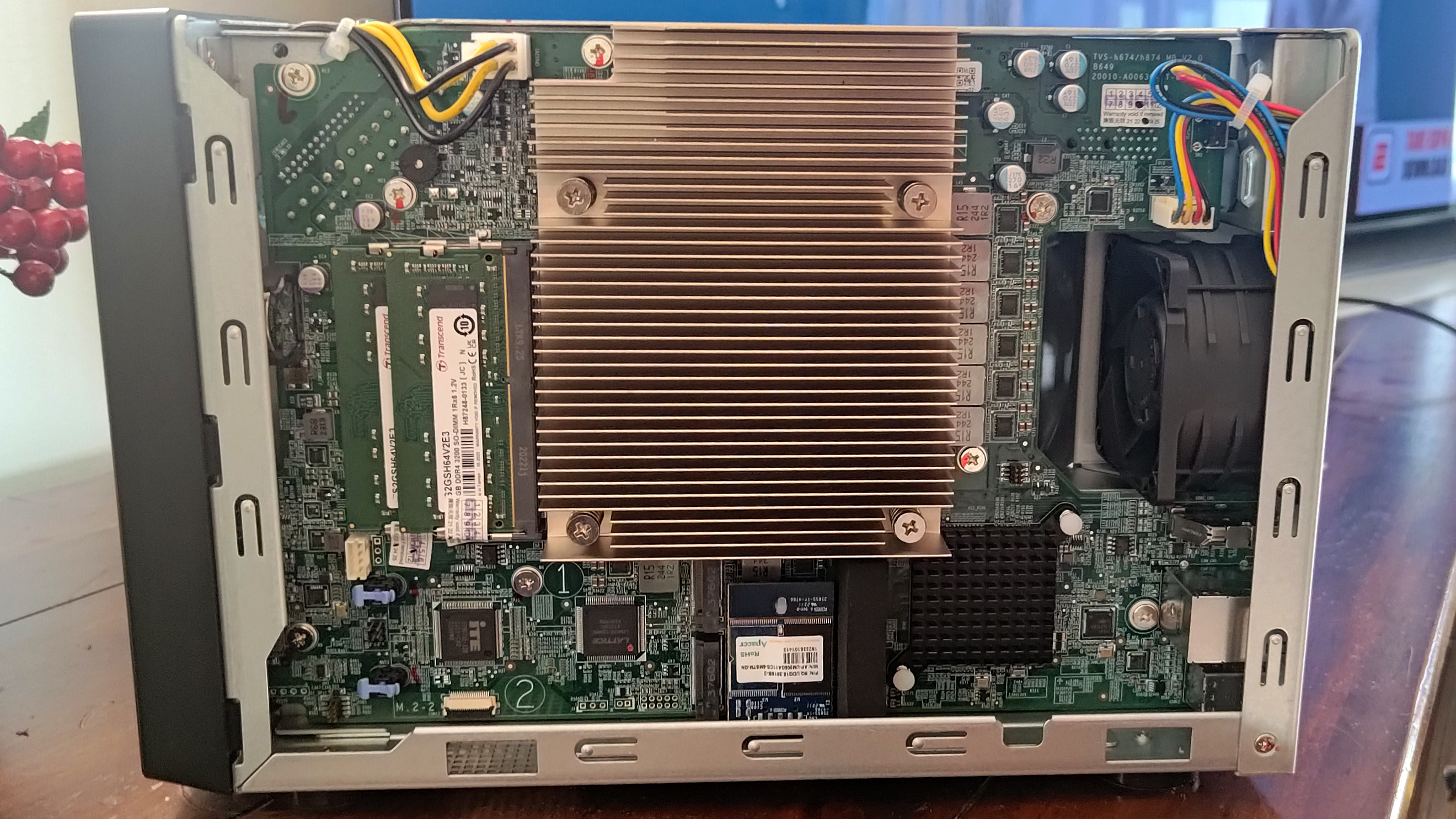
QNAP’s TVS-h674T fulfils the NAS-based promise of Thunderbolt 4 connectivity. It’s aimed at creators and small studios who want multiple users to be able to upload, edit and share 4K video across a network without relying on the traditional bane of multiple expensive, shared, single-connection, tethered hard drives.
There are six toolless, lockable and hotswappable 3.5-inch drive bays (included screws are needed for 2.5-inch SSDs). There are also two M.2 2280 PCIe 4.0 slots for fast NVMe drives that can be used for super-fast storage or SSD caching. For the latter, they can be optimised for virtualization and database applications (Random I/O) or file serving and media streaming (All I/O).
QNAP states that using six 22TB drives provides a maximum 110TB of formatted storage capacity, but this can be pushed to 352TB when using QNAP’s optional JBOD enclosures.
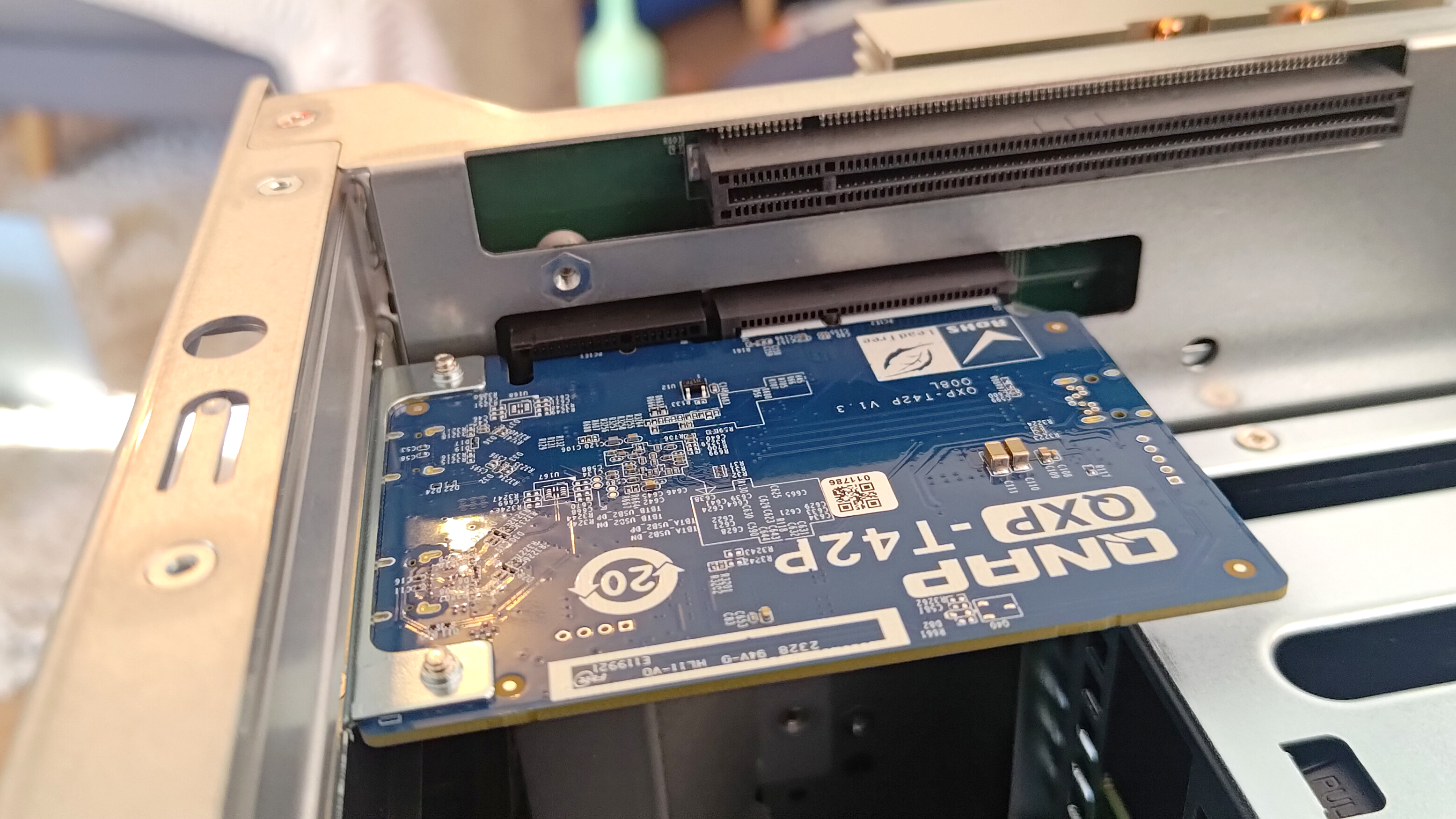
Just beware that you need to check QNAP’s website for drive compatibility, as few third-party drives are supported. Still, the fact that any are supported at all is a win considering that newer Synology NASes only support Synology-branded drives nowadays.
Two SODIMM slots are populated with two (non-ECC) 16GB memory modules (upgradable to 32GB). Note that QNAP recommends its own branded RAM but doesn’t require it. At the back are two 2.5Gb Ethernet ports, an HDMI 1.4b port, plus two USB 3.2 Gen 2 ports (Type-A and a Type-C). There’s another Type-C port at the front.
There are also two PCIe 4.0 slots. One (4 x4), comes populated with a two-port Thunderbolt 4 card. The other (4 x16) can be used to add additional, faster network ports (that facilitate up-to 25GbE speeds) or additional M.2 slots. It can also be used to add a small low-powered discreet graphics card for things like AI-based applications. You may need the latter, as the 12th-Gen Intel Core i5-12400 hexacore processor (with Hyperthreading) has a modest integrated UHD 730 GPU. It can transcode RAW footage on the fly, but will struggle with more-powerful demands.
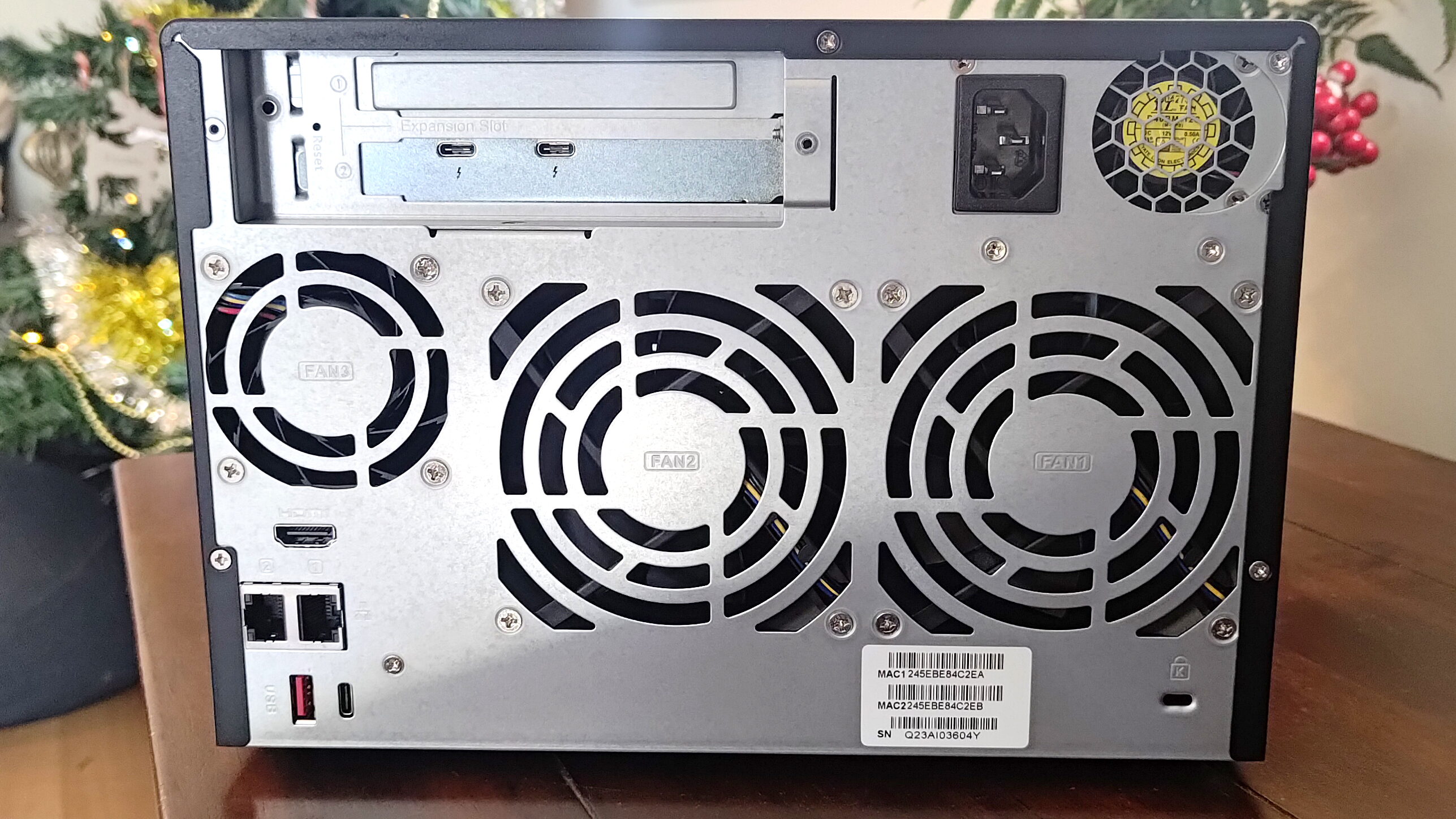
Set-up is simple, in that you plug it into your network, go to the supplied web address and follow the instructions. The QuTS hero 5.1.4 browser-based operating system is intuitive and makes setting-up storage and cache a breeze. It also comes with a well-stocked app store for just about any NAS application.
When used with SSD cache, we found that the theoretical 40Gbps Thunderbolt 4 connection speed wasn’t quite achieved. It’s hard to test over (even) our fast network environment (which also deals with theoretical speeds) but, while we couldn’t match the promised performance, we did see write speeds fluctuating around 600MB/s and read speeds hitting 1,700MB/s. If you work with video and are sick of hanging around, this will likely represent a significant improvement, but at this level the true benefits will heavily depend upon the file types you use and your network environment.
Final verdict
The QNAP TVS-h674T represents a significant investment that might, on the surface, appear like an extravagance in the six-bay NAS market. However, while it’s not cheap compared to slower rivals and siblings, the collective man-hours saved by the reduced transfer times of gargantuan UHD video files plus the potential for eschewing the procurement and management of multiple expensive tethered hard drives and also the ability for multiple team members to work on network-shared files (potentially remotely) mean it can quickly pay for itself in the right environment.
